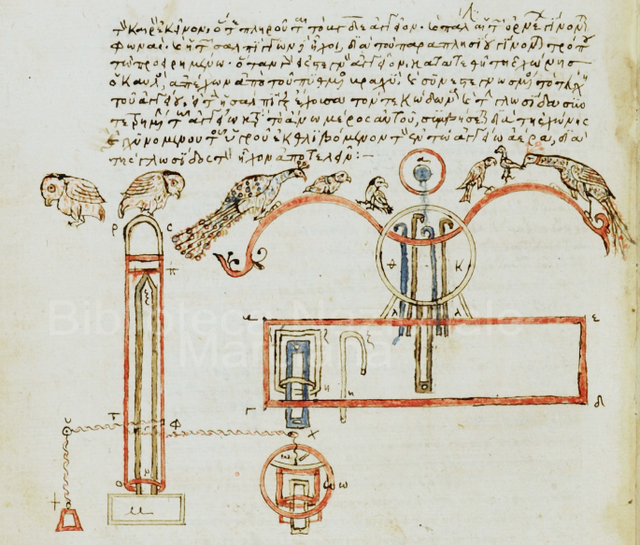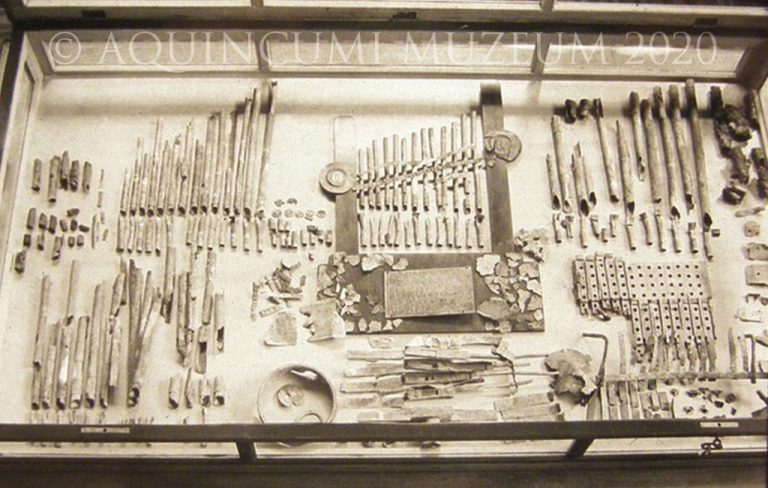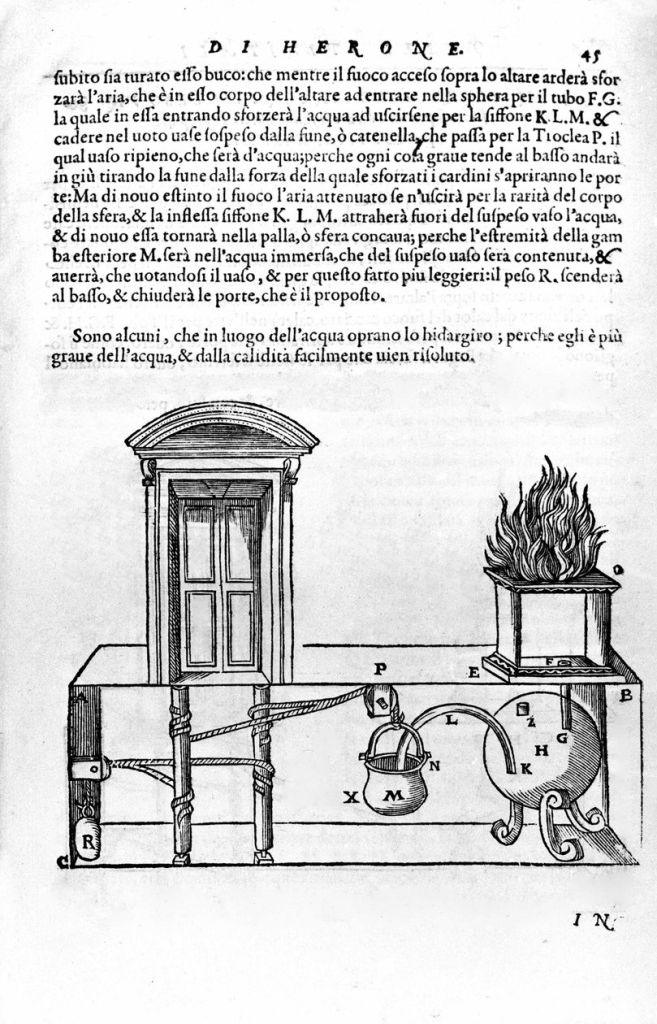Heron of Alexandria: the ancient engineer who brought physics to life
Heron of Alexandria: the ancient engineer who brought physics to life
- June 16, 2025
- 8:58 pm
- István Csányi
In a workshop tucked away in the great city of Alexandria around 62 CE, steam hissed from a peculiar metal sphere as it spun faster and faster, reaching over 1,500 revolutions per minute. This wasn’t magic—it was engineering. The device’s creator, a Greek scholar named Heron, had just demonstrated the first recorded steam engine, nearly 1,700 years before the Industrial Revolution would transform the world. But this remarkable invention was merely one thread in the rich tapestry of innovations that would earn Heron the title “Mechanikos”—the Engineer—and establish him as arguably the most excellent experimentalist of antiquity.
Heron of Alexandria represents a pivotal moment in human history when abstract mathematical principles collided with hands-on experimentation, producing technologies so advanced they wouldn’t be matched for over a millennium. His workshop was essentially the world’s first technical institute, where theoretical physics transformed into tangible machines that moved, calculated, and even entertained. Yet despite creating devices that seem impossibly modern—vending machines, programmable robots, and automatic door openers—Heron lived in a world of scrolls and styluses, where the greatest library ever assembled was slowly declining under Roman rule.
The genius of first-century Alexandria
Alexandria in Heron’s time occupied a unique position in the ancient world. Though the city had lost some of its former glory since the Ptolemaic golden age, it remained a cosmopolitan intellectual hub where Greek, Egyptian, and Roman cultures intersected. The famous Library and Museum continued to function during Heron’s lifetime. However, membership had shifted from being based solely on scholarly achievement to one that emphasized connections with government, the military, or athletic distinction. This change perhaps explains why Heron focused so intensely on practical applications rather than abstract theory.
This multicultural environment proved crucial to Heron’s development as an innovator. He drew freely from Babylonian mathematics, ancient Egyptian engineering traditions, and Greek scientific methods, synthesizing knowledge that had been accumulating for centuries. The city’s position as a crossroads between Europe, Asia, and Africa meant it was constantly exposed to new ideas through merchant networks. At the same time, its role as a papyrus production center ensured an abundance of writing materials for documenting his discoveries.
Heron taught at the Mouseion and likely served as its director, transforming it into what we might recognize as the first technical institute. His surviving works read like lecture notes and textbooks, covering mathematics, mechanics, physics, and pneumatics with the systematic precision of an experienced educator. Unlike many ancient scholars who focused purely on theoretical knowledge, Heron bridged the gap between abstract principles and practical application, creating a new model for how science could directly improve human life.
Engineering marvels that defied their time
The breadth of Heron’s inventions seems almost impossible for a single person to achieve. His workshop produced devices that wouldn’t be reinvented for centuries, each demonstrating a sophisticated understanding of physics principles that weren’t formally codified until much later.
The aeolipile stands as his most famous creation—a hollow bronze sphere mounted on a boiler through an axial shaft, with two bent nozzles positioned to create rotary motion as steam escaped. Water heated in the reservoir below created steam that rose through copper tubing into the sphere, then rushed out through the L-shaped nozzles at high speed. The resulting thrust spun the sphere rapidly, demonstrating the same principles that would later power Industrial Revolution steam engines and modern gas turbines. What makes this achievement even more remarkable is that Heron understood the reaction propulsion principle nearly two millennia before Newton formally articulated his laws of motion.

But Heron’s genius extended far beyond steam power. His coin-operated holy water dispenser—essentially the world’s first vending machine—solved a practical problem while demonstrating the principles of pneumatics. When worshippers dropped a coin onto a lever, it opened a valve allowing holy water to flow until the coin’s weight eventually caused it to fall off, automatically closing the valve. This simple device contained the seeds of modern automated commerce, requiring no human oversight while providing measured quantities of a valuable commodity.
Perhaps even more impressive were his programmable automata. Heron created an entire automated puppet theater that performed a 10-minute show using a complex system of ropes, knots, and simple machines operated by a rotating cylindrical cogwheel. Different knots triggered different actions as the rope unwound, creating what was essentially an early form of programming using physical rather than digital code. One performance told the story of Nauplius’s revenge, complete with sound effects generated by metal balls dropped onto hidden drums to simulate thunder.
His temple door opener demonstrated an understanding of thermodynamics that wouldn’t be formally theorized for another 1,800 years. When priests lit a fire on the altar, the heated air expanded, forcing water into a bucket. The bucket’s increasing weight pulled ropes connected to the temple doors, causing them to swing open automatically. To worshippers, this must have seemed like divine intervention, but Heron had harnessed the invisible power of thermal expansion.

The mathematics behind the magic
While Heron’s mechanical devices captured imaginations, his mathematical contributions provided the theoretical foundation that made such innovations possible. Heron’s formula for calculating a triangle’s area using only its side lengths remains a cornerstone of geometry: A = √s(s-a)(s-b)(s-c), where s represents half the perimeter. This elegant solution eliminated the need to know a triangle’s height, making area calculations practical for surveyors and architects working in the field.
Equally important was his iterative method for computing square roots—an algorithm so efficient that modern computers still use variations of Heron’s approach. His method for calculating cube roots and his work on the Heronian mean demonstrated a systematic approach to mathematical problems that emphasized practical utility alongside theoretical elegance.
The dioptra, Heron’s surveying instrument, represents the ancestor of the modern theodolite. This sophisticated device featured a circular table mounted on a stand, calibrated with angular measurements, and a rotating bar with sights that could tilt for vertical measurements. The dioptra enabled surveyors to map terrain with unprecedented accuracy, allowing for the massive construction projects that characterized the Roman Empire. Roman engineers used Heron’s surveying methods to build aqueducts, roads, and monumental architecture across three continents.
Innovation through synthesis
What distinguished Heron from his contemporaries wasn’t just his inventions, but his approach to innovation. Rather than working in isolation, he systematically combined existing technologies and principles to create entirely new capabilities. His method represented an early form of systems thinking, where complex mechanisms emerged from the integration of simpler components.
Consider his self-filling wine bowl, which used a float valve mechanism to maintain constant liquid levels—the same principle employed in modern toilet tanks. Or his syringe, a large precision device for controlling the delivery of air or liquids that found applications in medical procedures and mechanical systems alike. Each invention was built upon fundamental principles while solving specific practical problems.
Heron’s approach to documentation was equally systematic. His surviving works include detailed technical drawings with precise measurements, material specifications, and construction methods. He understood that innovation meant nothing without knowledge transfer, carefully recording his techniques so others could replicate and improve upon his designs. This commitment to sharing knowledge helped ensure that his ideas would survive the eventual decline of Alexandria as a center of learning.
Roman pragmatism meets Greek theory
The political context of Heron’s work shaped both its character and its limitations. Romans appreciated practical applications but showed less interest in abstract theoretical science. This pragmatic focus may have encouraged Heron’s emphasis on practical devices over pure research. Still, it also meant that some of his most advanced concepts—such as the steam engine—remained curiosities rather than becoming foundations for further development.
The abundance of slave labor in the Roman world may have reduced incentives for labor-saving mechanical devices. Why invest in complex machinery when human power was readily available? This economic reality helps explain why Heron’s steam engine never evolved beyond a demonstration device, despite containing all the essential elements of later Industrial Revolution technology.
Nevertheless, Roman support for engineering projects, especially those with military or entertainment value, provided Heron with resources and audiences for his work. His theatrical machines and temple effects served the Roman appetite for spectacle, while his surveying instruments and construction techniques directly supported imperial infrastructure projects. Emperor Claudius even built an extension to the Library during this period, demonstrating continued Roman investment in Alexandria’s intellectual capabilities.
The long journey to rediscovery
Heron’s influence on subsequent generations followed a complex path of preservation, translation, and rediscovery that spans over 1,500 years. Many of his original Greek texts were lost, surviving only through Byzantine manuscripts and Arabic translations created during the Islamic Golden Age. Islamic scholars, such as Al-Jazari and the Banu Musa brothers, expanded on Heron’s concepts, developing increasingly sophisticated automata and mechanical devices that preserved and enhanced his innovations.
The excellent translation movement of the Islamic world proved crucial for Heron’s legacy. His “Mechanica” survived only in Arabic translation by Kosta ben Luka (862-866 CE), while other works were preserved in manuscripts scattered across the medieval Islamic world. These translations maintained the technical details and illustrations necessary for others to understand and replicate his devices.
When Renaissance Europeans rediscovered these texts, the impact was immediate and profound. Federico Commandino’s Latin translation of “Pneumatica” appeared in 1575, sparking renewed interest in mechanical automation. Leonardo da Vinci’s notebooks demonstrate an apparent influence from Heron’s work, particularly in the design of automated mechanisms and the application of pneumatic principles. Bernardino Baldi’s Italian translation of “Automata” in 1589 and Giovanni Battista Aleotti’s translation of “Pneumatica” helped spread Heron’s ideas throughout Renaissance workshops and academies.
Modern echoes of ancient innovation
The principles Heron discovered and applied continue to shape contemporary technology in remarkable ways. Every jet engine operates on the same reaction propulsion demonstrated by his aeolipile, converting thermal energy into rotational motion through the controlled escape of high-pressure gases. Modern steam turbines, whether in power plants or naval vessels, employ variations of Heron’s basic design scaled up for industrial applications.
His programmable cart, which used pegs on rotating axles to control direction changes, anticipated the binary logic systems that govern modern computers and robotics. The concept of using physical markers to control sequence and timing appears throughout modern automation, from assembly line machinery to 3D printers. Heron’s approach to automation—breaking complex operations into simple, repeatable steps—remains fundamental to industrial engineering.
Perhaps most directly, his coin-operated holy water dispenser established the basic principles of vending machine operation that remain in use today. The mechanism of coin insertion triggering measured product delivery appears in everything from subway turnstiles to airport snack machines. Modern versions add electronic controls and credit card readers, but the core concept remains unchanged from Heron’s original design.
In hydraulic and pneumatic systems, Heron’s understanding of pressure relationships and force multiplication underlies modern industrial equipment. Construction machinery, manufacturing equipment, and automotive systems all employ variants of the principles he demonstrated with simple devices using water and air pressure. His Heron’s fountain continues to appear in physics classrooms worldwide, providing students with hands-on experience of pneumatic and hydraulic principles.
Lessons for contemporary innovators
Heron’s approach to innovation offers timeless insights for modern engineers and entrepreneurs. His success stemmed from combining deep theoretical knowledge with practical experimentation, never losing sight of real-world applications while pushing the boundaries of what was technically possible. He demonstrated that breakthrough innovation often emerges from the creative synthesis of existing technologies rather than completely original discoveries.
His systematic documentation practices established a model for knowledge sharing that remains relevant today. In an era before printing, Heron understood that innovations lived or died based on how effectively they could be communicated and replicated. His detailed technical drawings, precise measurements, and step-by-step instructions enabled others to build upon his work across centuries and cultures.
The interdisciplinary nature of Heron’s expertise—spanning mathematics, physics, engineering, and even entertainment—reflects the kind of broad thinking that drives modern innovation. Contemporary challenges in fields like renewable energy, artificial intelligence, and biotechnology require the same willingness to connect insights across traditional boundaries that characterized Heron’s approach.

Perhaps most importantly, Heron demonstrated that science and engineering serve humanity best when they remain grounded in practical needs while maintaining the ambition to transcend current limitations. His steam engine may not have triggered an industrial revolution in ancient Alexandria, but it preserved and transmitted principles that would eventually transform civilization. In our age of rapid technological change, Heron’s example reminds us that today’s curiosities may become tomorrow’s foundations, and that the patient documentation of experimental knowledge creates possibilities that extend far beyond any single inventor’s lifetime.
The workshop where steam first spun that bronze sphere has long since crumbled to dust, but the principles Heron discovered there continue to power our modern world. His legacy lives on not just in the specific devices he created but in the approach to innovation he pioneered—one that combined theoretical insight with experimental rigor, practical utility with visionary imagination, and local needs with universal principles. In an age when we’re still learning to harness the fundamental forces of nature, Heron of Alexandria remains both an inspiration and a guide, reminding us that the marriage of knowledge and craftsmanship can indeed bring physics to life.

Business Development at Machine Intelligence Zrt. Innovation professional with 25+ years of experience in IT solutions and product strategy. Science history enthusiast and digital fabrication hobbyist specializing in 3D printing, laser cutting, and CNC. Holds MSc degrees in Chemistry and Physics from the University of Szeged.


